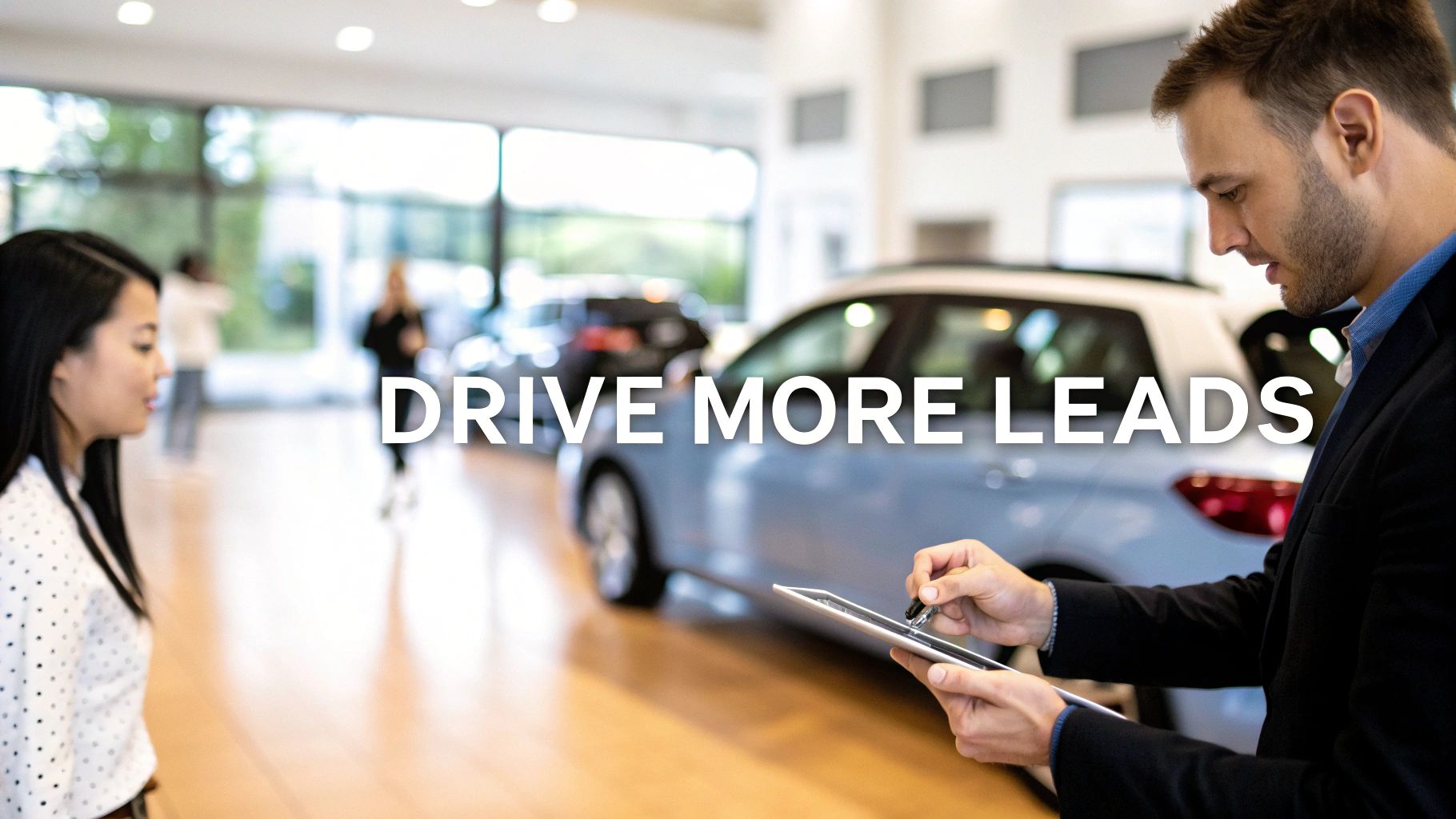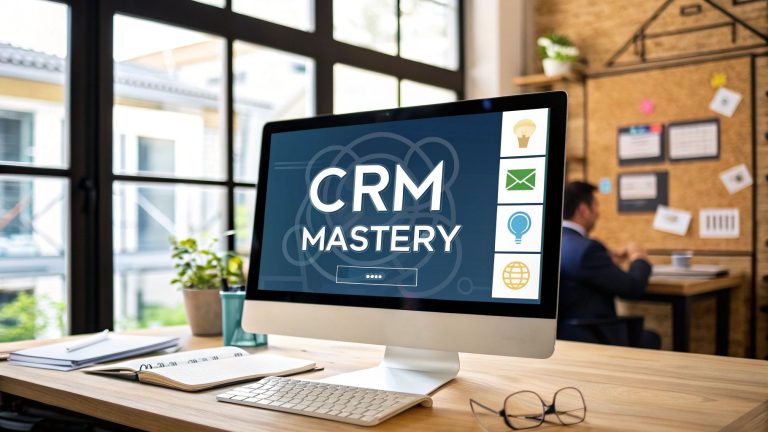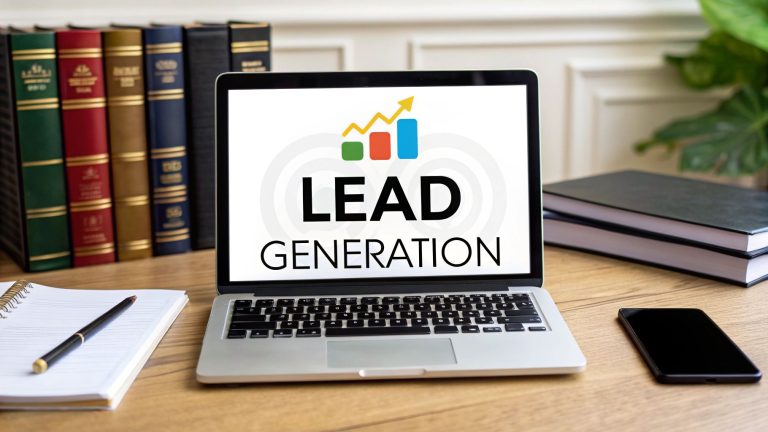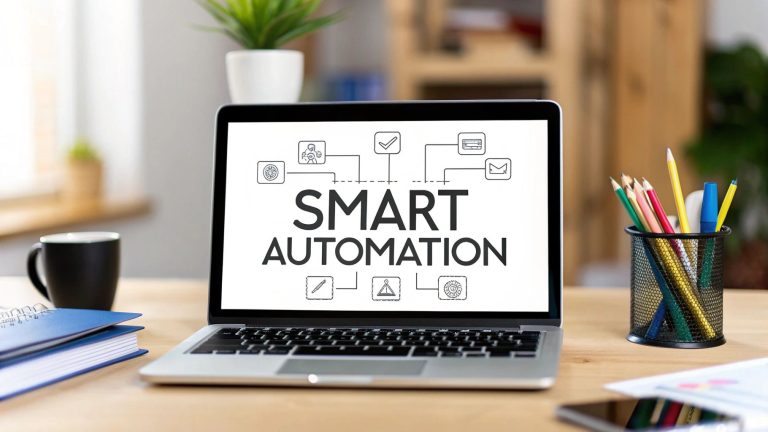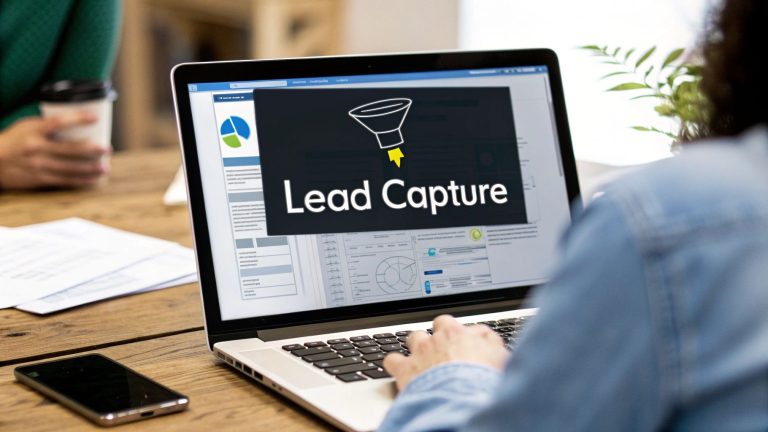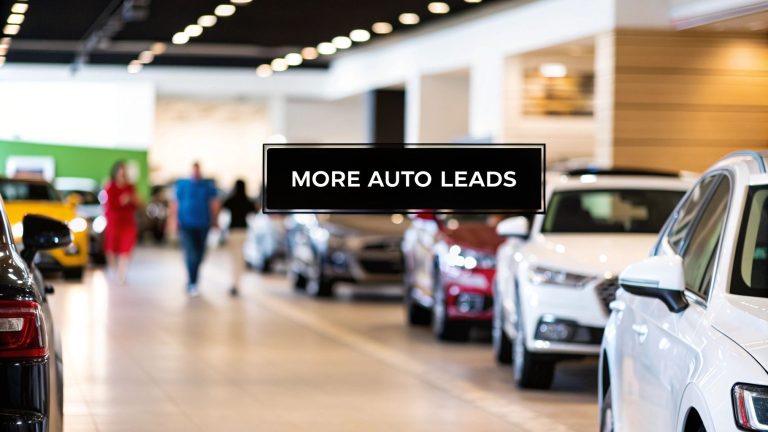Drive More Automotive Sales Leads
Let's be honest, car sales leads are the fuel that keeps any dealership running. They're the hand-raisers, the folks showing interest in buying a vehicle. But the real challenge today isn't just getting those leads; it's about snagging them and turning them into customers in a world that lives online. To really succeed, you have to ditch the old playbook and embrace a smarter, automated game plan.
Winning in the Modern Digital Showroom
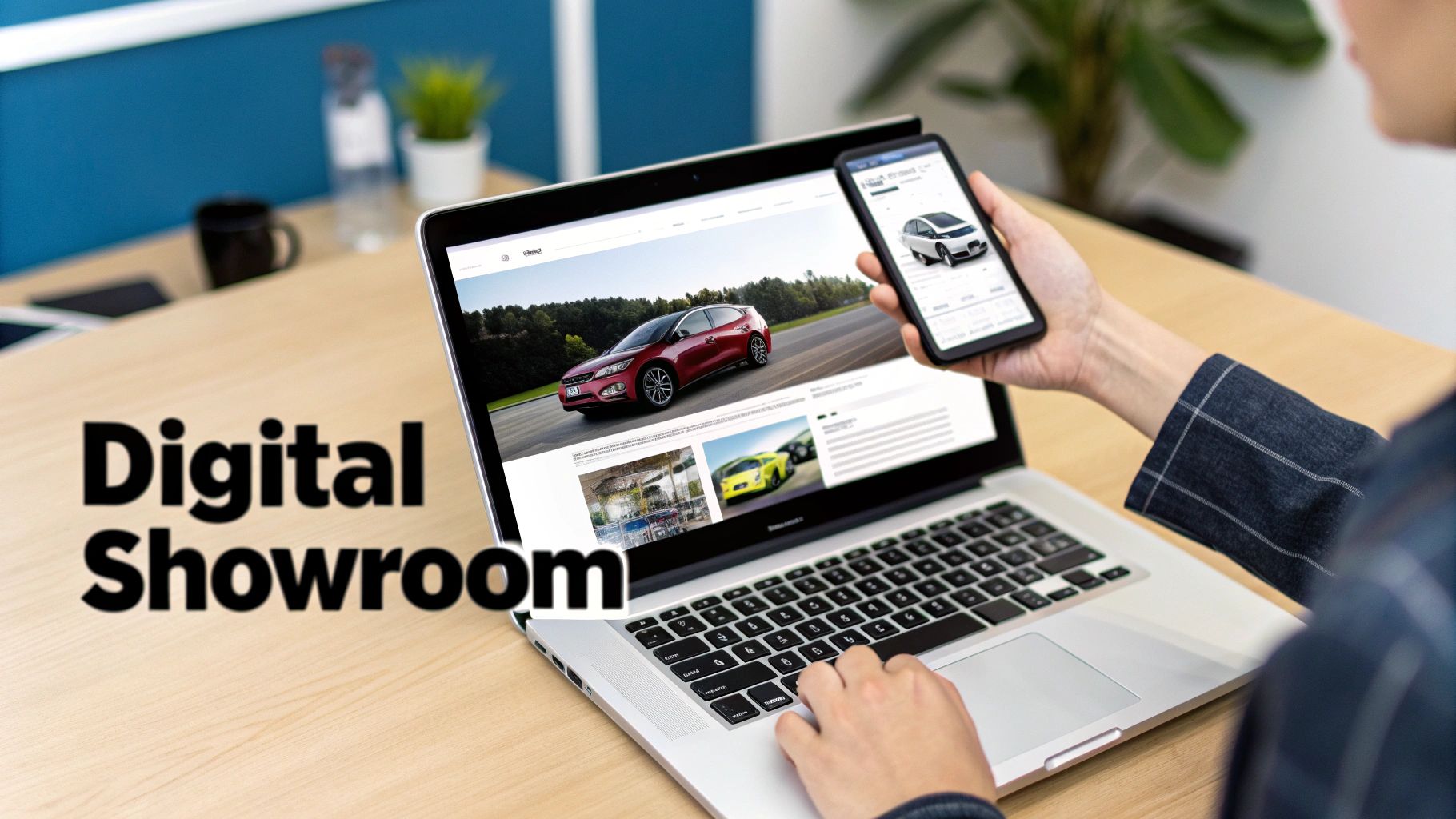
The path to buying a car doesn't start on the lot anymore. It starts with a scroll, a search, and a click. Your showroom is no longer just the building with the big glass windows—it's now a digital space where a potential buyer's first impression is formed long before they ever think about stepping inside.
This shift means old-school metrics like foot traffic just don't tell the whole story.
Today's buyers are researchers. They're jumping online to compare models, dig through reviews, and hunt down pricing info, arming themselves with knowledge before they even consider talking to a salesperson. If your dealership doesn't have a rock-solid online presence and a smooth way to capture their interest, you're not just falling behind—you're becoming invisible.
In today's market, generating leads and converting them presents a unique set of hurdles for dealerships. The digital shift has fundamentally changed customer behavior, and keeping up requires a new approach.
Here's a quick look at the major roadblocks dealerships are facing right now:
Key Challenges in Modern Automotive Lead Generation
| Challenge | Impact on Dealership | Key Statistic |
|---|---|---|
| High Lead Costs | The price of getting a single potential customer's attention has skyrocketed, squeezing marketing budgets and raising the stakes for every lead. | The average cost per lead is $283, making each one a significant investment. |
| Delayed Follow-Up | In a world of instant everything, even a short delay in response can mean a lost sale to a faster competitor. | Nearly 23.5% of leads don't get a response within 24 hours. |
| Manual Lead Handling | Relying on manual data entry and follow-up is slow, prone to errors, and simply can't keep up with the speed and volume of online leads. | An alarming 13.3% of leads are lost before they're even entered into a CRM. |
| Informed Customers | Buyers do their homework online first. If you can't provide value beyond what they've already found, you lose credibility. | A massive 95% of car shoppers use online resources before ever visiting a lot. |
These challenges highlight a critical gap: dealerships are spending more than ever to get leads, but outdated processes are letting those expensive opportunities slip through their fingers.
The High Cost of Missed Opportunities
Getting noticed in this crowded online space isn't cheap. With the average cost to generate a single automotive sales lead now at $283, every single prospect is incredibly valuable. And considering a staggering 95% of car shoppers now use the internet to do their homework before visiting a dealership, you'd think every online inquiry would be treated like gold.
You can dive deeper into these automotive marketing stats over at invoca.com.
But here's where things fall apart: the follow-up. Gaps in communication and slow response times are silent killers, creating leaks in your sales funnel where genuinely interested buyers just drift away.
Nearly a quarter (23.5%) of dealer leads fail to receive follow-up contact within 24 hours, while an alarming 13.3% of leads disappear entirely before even being entered into a CRM.
This delay is a massive failure. A lead that has to wait is a lead you're basically handing over to the competitor down the street who responds faster.
Bridging the Gap with Automation
The answer isn't to work harder; it's to work smarter by building a system that meets customers exactly where they are. This guide is going to walk you through how to build a powerful, automated lead generation machine using tools like Facebook Lead Forms and LeadSavvy Pro.
You’re about to learn how to:
- Attract high-intent buyers with ad campaigns that actually speak to them.
- Capture lead info instantly without anyone having to type a single thing.
- Automate your follow-up so every single lead gets an immediate, personal touch.
By closing these gaps in your process, you can completely transform your dealership’s ability to turn online interest into showroom appointments and, most importantly, closed deals. This is how you win in the modern digital showroom.
Crafting Facebook Ads That Buyers Can't Ignore
Just boosting a post from your dealership's page is like tossing a handful of flyers into the wind. Sure, some might land where you want them, but it’s mostly just hope. To pull in real, quality automotive sales leads, you need to get surgical with your strategy. This is where Facebook Lead Ads become your direct pipeline to buyers, but only if you build the campaign right.
Forget about generic targeting like "cars" or "trucks." That’s a surefire way to burn through your budget. The real magic happens when you dial in on audiences who are showing clear signs they're ready to buy. Facebook’s detailed targeting lets you zero in on people who are actively in the market, have recently visited sites like Autotrader, or even follow your competitors' pages. This is how you stop wasting money on casual browsers and focus on motivated buyers.
Designing Creative That Stops the Scroll
Let's be blunt: a blurry photo of your lot isn't going to cut it. Your ad's visual is your one shot to stop someone from scrolling past. You need high-quality, eye-catching images or short, punchy video clips that put a specific, desirable model front and center.
Think about what makes a car truly appealing and show that off.
- Interior Shots: Got a panoramic sunroof or a slick infotainment system? Highlight it.
- Exterior Angles: Use dynamic shots that scream performance or style.
- Action Clips: A short video of a truck handling rough terrain or a sedan cruising down a scenic road does more selling than a paragraph of text ever could.
This kind of visual hooks a buyer’s emotions and makes them curious enough to actually read your ad. For a deeper dive, there are some great resources on automating high-converting Facebook video ads that can take your strategy to the next level.
Once you have their attention, your ad copy needs to immediately answer their one burning question: "What's in it for me?" Get straight to the point and address their biggest motivations. Frame your offer with benefits that feel valuable and urgent.
A great ad doesn't just display a vehicle; it presents a solution. Whether it's a killer financing rate, a guaranteed trade-in value, or an exclusive offer that expires this weekend, your copy needs to create a little FOMO (fear of missing out).
Optimizing Your Lead Form for Quality
Okay, they clicked. Don't lose them now. The lead form is the final step, and your goal is simple: make it as easy as possible to complete. Every single field you add is another reason for someone to bail.
This example from Meta nails it—it's clean, simple, and built for speed.
See how it pre-fills the name and email? That small detail removes friction and does the work for the user.
Stick to the absolute essentials: name, email, and phone number. If you really need more, add just one or two simple qualifying questions, like "What vehicle are you interested in?" or "When are you looking to purchase?" This helps your sales team qualify leads without scaring prospects away.
For more in-depth strategies, check out our complete guide covering the best practices for high-performing Facebook ads.
By thoughtfully crafting every piece of your ad—from the audience to the final click—you create a smooth path that turns a casual scroller into a hot, actionable lead for your team.
Building Your Automated Lead Response Machine
The second a prospect hits "submit" on your Facebook Lead Form, a clock starts ticking. Loudly. A fresh lead has an incredibly short shelf life, and in this game, speed isn't just an advantage—it's everything. Building an automated system is how you guarantee that every single one of your hard-won automotive sales leads gets a professional, immediate response, day or night.
This isn't just about blasting out a generic email. We're talking about creating a seamless workflow that closes the gap between a Facebook click and a real conversation with your sales team. A well-built machine instantly captures the lead, sends it to the right person, and starts engaging the prospect, all within seconds.
The visual below breaks down the simple, three-part process of getting these leads in the door through Facebook Ads.

This Target, Design, Capture flow is the front-end of your lead machine. But the real magic, the part that actually makes you money, happens in the moments right after that "Capture" stage. That's where automation takes over.
Setting Up Instant Lead Engagement
First things first: you need to connect your Facebook Lead Form to a tool like LeadSavvy Pro. This connection is the trigger that kicks off your entire follow-up sequence the moment a lead comes in. Forget downloading CSV files manually; this makes the data flow automatically and instantly where it needs to go.
Your initial automated response has two simple goals: confirm you got their info and set expectations. A great way to do this is with a one-two punch:
- Automated Email: Send a branded email thanking them for their interest. Make sure it confirms the specific vehicle they inquired about and tells them a specialist will be in touch shortly.
- Automated SMS: A quick text has a ridiculously high open rate. Something as simple as, "Hi [Name], thanks for your interest in the Ford F-150 at [Dealership Name]. A team member will call you soon to answer your questions," creates an immediate, personal connection.
The goal of that first touchpoint isn't to sell the car. It's to acknowledge the customer and reassure them that a real human is on the case. This simple act builds a foundation of trust from the very first interaction.
Intelligent Lead Routing and Notifications
Not all leads are created equal, so they shouldn't all land in the same inbox. A smart automation workflow can instantly route leads based on what the prospect is looking for.
For instance, an inquiry about a new truck can be automatically assigned to your top truck specialist, while a question about a used sedan goes straight to the pre-owned department. At the exact same moment, the system should fire off an instant notification to that salesperson's phone and email, complete with the lead’s contact info and the vehicle they want.
This completely eliminates "lead limbo"—that dead time where a prospect waits while someone at the dealership tries to figure out who should handle the call. By the time a competitor gets around to responding, your assigned salesperson is already prepping for a personalized call.
This turns a simple form submission into a warm, qualified opportunity for your sales team. You can see a great marketing automation example of how these workflows are structured to create a fully automated, efficient, and responsive system.
Turning Quick Responses into Showroom Visits
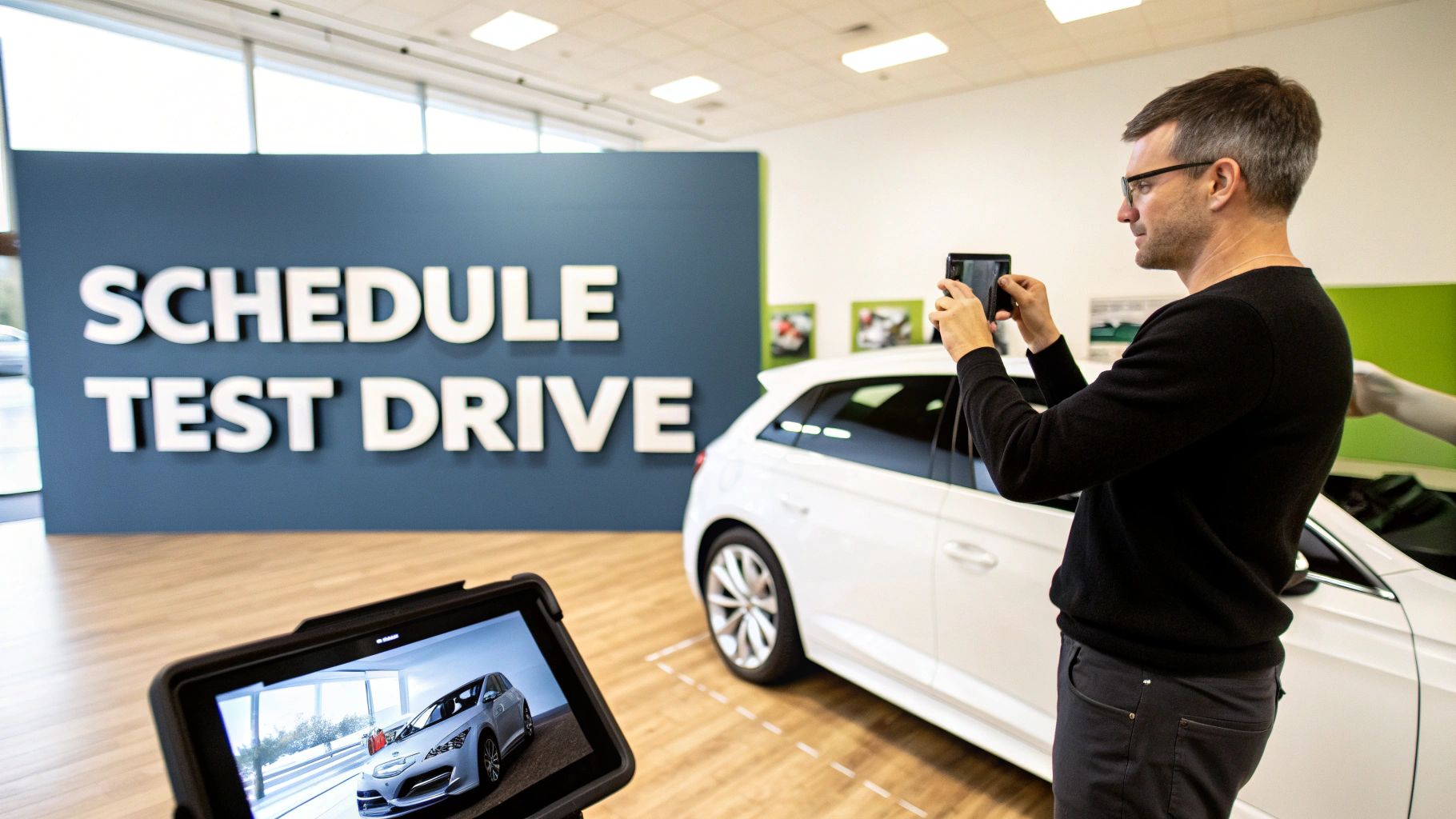
That first automated response is a great opener, but it’s just the digital handshake. The real magic happens in the follow-up. It's the personalized, strategic communication that convinces a lead to leave their couch and visit your showroom.
Speed gets your foot in the door, but genuine value is what brings them in.
Think about it: the chances of even contacting a lead plummet by over 10 times in the first hour. That’s your golden window. You have to move past the automated text and start building a real connection that guides them from casual online interest to a scheduled test drive.
Crafting a Multi-Channel Nurture Sequence
The trick is to connect with your automotive sales leads where they already are—on their phones and in their inboxes—without being annoying. A smart mix of email, text, and an actual phone call establishes a presence that feels professional and persistent, not pushy.
You're not trying to bombard them; you're offering help at every turn.
Here’s a simple, battle-tested sequence that just works:
- First 5 Minutes (Automated): The instant email and SMS confirmations fire off. This is LeadSavvy Pro doing the heavy lifting.
- 15-30 Minutes (Manual): A salesperson picks up the phone. This isn't a hard sell. It's a quick call to answer any immediate questions and offer assistance.
- 24 Hours Later (Semi-Automated): A follow-up email lands, packed with value. Maybe it's a link to a video walkaround of the exact car they're interested in, or a quick look at similar models in your inventory.
- Day 3 (Manual): A friendly, low-pressure text message. Something simple like, "Hi [Name], just checking if you had any other questions about the Silverado. Let me know if you'd like to schedule a time to see it in person this week."
The most effective follow-up strategies provide value, not pressure. Your goal is to be a helpful resource, making the car-buying process easier for the prospect. This approach builds trust and keeps your dealership top of mind when they're ready to act.
So, how much of a difference does this really make? Let's break it down.
Manual vs Automated Lead Follow-Up Comparison
A lot of dealerships still rely on salespeople manually checking for leads and following up when they have a spare moment. But "when they have a spare moment" often means hours later, and by then, the lead has gone cold. An automated system like LeadSavvy Pro changes the game entirely.
| Metric | Manual Follow-Up | Automated Follow-Up (with LeadSavvy Pro) |
|---|---|---|
| Response Time | Hours to days (if at all) | Under 5 minutes (often seconds) |
| Contact Rate | Low (under 20%) | Dramatically higher (over 80%) |
| Consistency | Inconsistent, depends on staff | 100% consistent, 24/7 |
| Showroom Visits | Lower, leads lose interest | Significantly higher, engagement is immediate |
| Staff Workload | High, requires constant monitoring | Low, automation handles initial contact |
The table makes it pretty clear. Relying on manual follow-up is like choosing to walk when your competition is driving a sports car. Automation gives you the speed and consistency needed to win in today's market.
Personalization That Drives Action
Generic, copy-pasted templates are the fastest way to get ignored. If you want to stand out, your follow-up needs to feel like it was made just for them. The great news is, your Facebook Lead Form already gave you everything you need to do this.
Forget the boring, templated email. Imagine this instead: your salesperson grabs their phone, walks out to the lot, and records a quick, personal video message.
"Hey [Name], I saw you were interested in the Highlander with the panoramic sunroof. Just wanted to give you a quick look at it—it's even better in person!"
This simple gesture takes two minutes but has a massive impact. It shows you’re paying attention and willing to go the extra mile. For more scripts and advanced strategies, check out our complete guide to mastering the art of lead follow-up.
Ultimately, getting more showroom visits is about bridging the gap between the digital and physical worlds. Use automation for speed, but lean on personalized, human interaction to build the kind of connection that gets a buyer excited to come in for that test drive.
Adapting Your Strategy to Market Trends
Pulling in high-quality automotive sales leads takes more than a killer ad campaign. It requires a sharp eye on what's happening outside your dealership doors. Economic shifts, the latest tech, and even supply chain hiccups all influence what your customers are searching for and, ultimately, what they'll buy.
Ignoring these trends is like driving blind.
A flexible strategy is your best friend here. It lets you pivot your marketing message to match what buyers are thinking about right now. When gas prices shoot up, a smart dealership immediately shifts its ad creative to highlight fuel-efficient sedans or the latest hybrid models. It’s a simple tweak that makes your ads instantly more relevant and powerful.
Tuning Into the EV Revolution
Let's be real: the rise of electric vehicles is one of the biggest shake-ups our industry has seen in decades. This isn't some far-off trend—it's happening now, and it's changing the kind of leads you need to be generating.
As more people get curious about EVs, your campaigns have to meet that demand head-on. This is your chance to run highly targeted ads aimed squarely at your EV and hybrid inventory.
Be sure to highlight the benefits these specific buyers care about:
- Lower Fuel Costs: Drive home the long-term savings they'll see by skipping the pump.
- Government Incentives: Make sure they know about any available tax credits or rebates that sweeten the deal.
- Performance and Tech: Talk about the instant torque, the silent ride, and all the cool tech that makes the EV experience unique.
Smart dealerships don't see the EV movement as a headache, but as a massive opportunity. When you tailor your ads to this growing and motivated group of buyers, you position yourself as the forward-thinking leader in your market.
This isn't just a local fad, either. Projections show that electric vehicles now account for a whopping 23% of all new consumer vehicle sales globally. The Asia-Pacific region is leading the charge with a 68% market share, proving this is a worldwide consumer shift. You can explore more about the global automotive outlook on alixpartners.com to get the bigger picture.
Navigating Economic and Inventory Headwinds
Beyond shiny new tech, the everyday economy has a huge impact. Rising interest rates can make buyers think twice about financing. Your response? Create ads that put attractive financing offers or lease specials front and center. This shows you get their concerns and have a solution.
Your own inventory levels are another major signal. Got a surplus of a particular truck model? That’s your green light to launch a focused campaign with aggressive pricing or special package deals for that exact vehicle.
On the flip side, if a popular SUV is in short supply, you can shift your messaging. Encourage pre-orders or build hype around incoming stock. This creates urgency and lets you capture leads before the vehicles even hit the lot.
By staying plugged into these market dynamics, you can make small but powerful adjustments to your lead generation, ensuring your campaigns are always sharp, relevant, and perfectly timed to meet buyers right where they are.
Your Top Automotive Lead Gen Questions, Answered
Jumping into any new digital strategy is going to stir up some questions. When it comes to pulling in automotive sales leads from a platform like Facebook, I hear a lot of the same concerns from dealership teams. You're wondering about timelines, what metrics actually matter, and how all this fancy tech fits with what you're already doing.
Let's clear the air and tackle those common questions head-on. My goal is to give you the clarity and confidence to put these strategies to work.
How Quickly Can We Expect Leads from a New Campaign?
This is the big one, right? While every ad campaign has its own rhythm, it’s pretty common to see the first leads start trickling in within 24 to 48 hours after you hit "launch." Think of this initial period as the data-gathering phase—the platform's algorithm is just waking up and learning who to show your ads to.
But the real magic, where you start dialing in both lead quality and cost, usually takes a couple of weeks. During that time, you'll be tweaking your audience targeting, A/B testing different ad images or videos, and figuring out which offers really get buyers clicking. Sticking with it during this "learning phase" is absolutely critical for getting the long-term results you want.
What Is the Single Most Important Metric to Track?
Cost Per Lead (CPL) is a great place to start, but honestly, it doesn't tell you the full story. If you want to know what's really working, the most important metric to obsess over is your Cost Per Appointment Set or, even better, your Cost Per Sale.
A cheap lead that never answers the phone or sets foot in your showroom is completely worthless. When you focus on metrics tied to actual sales pipeline movement, you get a crystal-clear picture of your ROI. It helps you spend money on attracting people who are ready to talk, not just click.
This mindset shift ensures your ad budget is directly fueling real business growth, not just chasing empty numbers. For a deep dive into more battle-tested strategies, this expert automotive lead generation playbook is an incredible resource.
Can This Automated System Integrate with Other Lead Sources?
Absolutely. While this guide focuses heavily on Facebook Lead Forms, a smart automation tool like LeadSavvy Pro is designed to be the central command center for all your lead sources. It’s the brain of your entire digital sales operation.
You can easily plug it into your other key channels, making sure every single inquiry—no matter where it comes from—gets the same instant, consistent follow-up.
This means you can integrate it with:
- Your Dealership Website: Automatically capture and respond to leads from your "contact us" or "get a quote" forms.
- Third-Party Marketplaces: Funnel leads directly from popular sites like Cars.com or Autotrader into your system.
- Other Digital Marketing Channels: If you're getting leads from somewhere else online, you can connect that source, too.
This unified approach guarantees that no lead ever falls through the cracks. It also ensures your team maintains a professional and lightning-fast response time across the board, which is exactly what today's car buyers expect.
Ready to stop losing valuable leads and start turning Facebook clicks into showroom visits? LeadSavvy Pro automates your entire lead capture and follow-up process, ensuring every prospect gets an instant response. Try it for free and see the difference at https://leadsavvy.pro.

